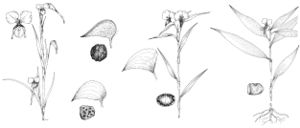Commelina gambiae
in A. L. P. de Candolle and C. de Candolle,Monographiae Phanerogamarum 3: 146. 1881.
Herbs, annual, 10–30 cm. Stems ascending to decumbent. Leaves: blade sessile, linear to linear-lanceolate, 2–15 × 0.3–1 cm, glabrous or sparsely hirsute. Inflorescences: proximal cyme ± 2-flowered, distal cyme absent; spathes solitary, whitish basally, pedunculate, usually slightly falcate, 0.9–2 × 0.4–1 cm, margins distinct, connate basally, apex acuminate, sparsely hirsute; peduncles 0.3–1.6 cm. Flowers bisexual, less than 1 cm wide; proximal sepals connate, forming cup; paired petals apricot or peach-colored, proximal petal white, minute; staminodes 3; antherodes yellow, cruciform. Capsules 3-locular, 3-valved, 4–5.5 mm. Seeds 5, brown, 1.9–2.7 × 2–2.4 mm, reticulate. 2n = 56.
Phenology: Flowering fall.
Habitat: Roadsides, pastures, and levees
Distribution
Introduced; Fla., native, w Africa
Discussion
Commelina gambiae was first found in Florida in 1976 and is now recorded from five counties. Commelina nigratana var. nigritana, which is unknown outside of Africa, differs by having three one-seeded locules, the seeds each with two pits and lacking the reticulation.
Selected References
None.
